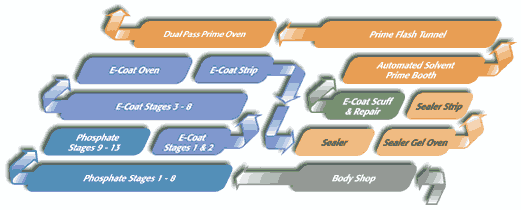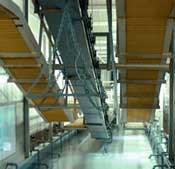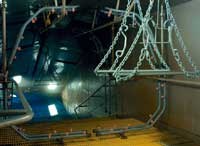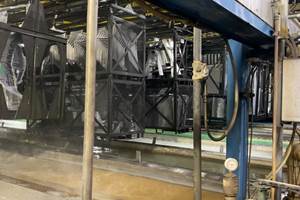Phasing In
When Ford Motor Company made the decision to expand the paint shop in its St. Thomas Assembly Plant, it sought to do so without losing production time and without sustaining any “lost day” injuries…
Located along the northern shores of Lake Erie—with Detroit to its west and Buffalo to its east—is St. Thomas, Ontario. Those familiar with St. Thomas likely know it for its historical connection to eight different railways, or possibly its massive “Jumbo the Elephant” monument (which commemorates the life and untimely death of the famed circus star at the hands of a locomotive). But in the automotive world, the city is best-known as the residence of Ford Motor Company’s St. Thomas Assembly Plant.
The St. Thomas plant is the home of the Ford Crown Victoria and the Mercury Grand Marquis. To date, more than seven-million vehicles have been produced at the plant. In 2002, the St. Thomas plant also began production of the Mercury Marauder, the updated version of the 1960’s muscle car of the same name.
In 1999, the decision was made to expand the plant’s paint shop. Although the project would be significant—the expansion would almost double the plant’s size to a massive 2.6 million sq ft—Ford needed to be able to complete the expansion without losing man-hours, or having stoppages in production. The solution? Install the new system in phases, so that existing production operations could continue uninterrupted even as the new system was installed. For assistance, the company turned to Eisenmann Corporation, a supplier of turnkey painting systems.
Installing a System in Phases
Together, Ford and EISENMANN developed an aggressive schedule that broke the system installation down into five phases of production.
Phase One. The first phase of the project revolved around the construction of a new building, which would house a new 13-stage phosphate system and eight-stage electrocoat system. Phase one—which began in January 2000—took approximately 12 months to complete, making it the single most time-consuming aspect of the project. Responsible for two-thirds of Ford’s total investment, it was also the most costly.
“Phase one was both one of the most challenging aspects of the project, but at the same time, one of the easiest,” says Geoffrey Somary, vice president of Eisenmann Corporation. “We were on a very aggressive schedule, but we had the freedom that comes with working in a new space unconnected to the existing processes.” Though phases two through five were considerably smaller in their scope, they were more closely integrated into the workings of the plant.
Phases Two and Three. Following the completion of phase one, engineers focused on demolishing the old phosphate and electrocoat lines, and began installation of a sealer line and e-coat oven. Phases two and three began in January 2001 and took approximately four months to complete.
Phase Four. EISENMANN’s Don Cook, project manager, says that phase four—the installation of a new prime booth—was one of the single-most challenging phases of the project. “It was one of the most difficult phases of the project from the standpoint of accessibility to the plant,” he says. “We had to operate in and around an operating paint shop that was in production.” An additional consideration was that, unlike a “from scratch” installation where the contractors would start from the center of the facility and work their way out, the unique circumstances behind the Ford installation required that the team work its way inward, making the logistics of equipment delivery and installation increasingly complex as the project went along.
Phase Five. Following the installation of the new prime booth, the old prime booth was demolished and removed from the site. Phase five—which also featured the installation of a new flash tunnel—began in March 2002 and concluded in August of the same year.
Each new phase of the project began with a period of “standby and support” for the previous stage. Because Ford’s schedule demanded that each phase begin production immediately after being completed, there was precious little time available for testing and tweaking of the system. That meant that mechanical and technical issues—as well as training of the Ford-line workers—had to be addressed on the spot. “When you start a system this aggressively,” says Somary, “you don’t have the benefit of testing, testing and more testing. You start the line up and it is expected to operate properly. If there is a problem or technical fault, you fix it right then. You can’t put a call into your supplier and wait five hours for somebody to show up, because in that five hours, a whole lot of cars aren’t getting made.” The support and standby aspects of each phase ensured that someone was on hand at all times in case a problem arose.
Planning… and More Planning
They key to installing a system in phases, says Cook, is planning—lots of it. “Scheduling was extremely important, because of the fact that in scheduling this installation we had to schedule around the workers’ downtime.” As an example, he points to the construction of a 20-foot-deep pit that would ultimately house the tanks for the prime booth. The project team had to isolate the construction area from the rest of the paint shop so as to prevent dust and dirt from contaminating other areas of the paint shop. Tasks like dirt removal and cement installation also had to be scheduled around the workers’ downtimes. “We worked a lot of weekends,” he says.
“The challenge is that you continually have to look at the whole picture even though you’re not even started on some aspects of the project,” adds Somary. “All of the work you’re doing has to be in line with the vision of the project as a whole.”
Communication was also a key factor in the success of the project. “We made sure that everyone—including the plant owner and shop workers—was involved in the pre-planning of each new phase,” says Cook. “We wanted everyone on the same page, and we wanted everyone looking out for each other. Once the project started moving forward and [the job shop workers and sub-contractors] saw that it would make life easier on themselves, it was easy to convince people that they needed to become active participants in the planning process.”
For Cook and his team, the careful planning paid off. Not only was the project completed on schedule in 2002, but EISENMANN’s efforts at the St. Thomas facility helped earn the supplier its status as a Ford Q1 Supplier. The Q1 program is defined by Ford as ”a back-to-basics quality process that requires a collaborative partnership with its suppliers, uses clear metrics, rigorous site assessment and stresses continual improvement.”
Making Safety “Job One”
During the expansion, Ford’s highest priority was the safety of its workers. Though automakers take “lost day” injuries far more seriously than they did 20 years ago, the industry average is currently hovering around 15 days per year per plant. Because the St. Thomas workers were saddled with the additional responsibility of trying to do their jobs in the midst of what was essentially a construction site, safety became even more of a priority.
“All of us took safety very seriously,” says Cook. “It was the number one topic in all of our discussions, meetings and project reviews.” The EISENMANN project team held daily meetings on the job site and, in turn, required its sub-contractors to have daily meetings with their workers. Project managers would occasionally show up unannounced to make sure that the contractors were following through with their safety commitments.
As various aspects of the project were completed, EISENMANN’s safety officer prepared specialized guidelines that would focus on especially important considerations of the upcoming work. “We tried anticipating the types of work we were going to be doing and what we should emphasize prior to beginning that work as far as safety measures and the types of things to look out for,” Cook says.
Thanks to the efforts of all the parties involved in the project, zero lost day injuries were recorded during the expansion. “I wish I could tell you that we had some kind of magical formula [for ensuring safety],” Somary says. “But when it comes down to it, our success was simply a matter of making safety a priority.”
Related Content
TTX’s Automated Conveyor Carrier System Offers Wireless, Flexible Operation
ACC system designed for reliable, consistent point-to-point movement of everything from small to heavy parts.
Read MoreMasking Solutions Provider CFS Dramatically Expands Capabilities and Capacity
Custom Fabrication & Supplies (CFS) completed a new plant expansion packing 10 times the capacity into twice the space. It dramatically enhances the supplier’s custom capabilities to provide extremely precise and cost-effective masking solutions.
Read MoreInstalling an Ecoat Line
Thinking of investing in electrocoating capabilities? George Lovell, coatings plant manager for Lippert, discusses considerations you should keep in mind as you add your ecoat line.
Read MoreTake Full Advantage of Industry Events
As travel plans ramp up for the year, what industry events will you attend? Products Finishing offers a quick look at some of the upcoming opportunities for 2024.
Read MoreRead Next
Episode 45: An Interview with Chandler Mancuso, MacDermid Envio Solutions
Chandler Mancuso, technical director with MacDermid Envio discusses updating your wastewater treatment system and implementing materials recycling solutions to increase efficiencies, control costs and reduce environmental impact.
Read MoreEducation Bringing Cleaning to Machining
Debuting new speakers and cleaning technology content during this half-day workshop co-located with IMTS 2024.
Read MoreDelivering Increased Benefits to Greenhouse Films
Baystar's Borstar technology is helping customers deliver better, more reliable production methods to greenhouse agriculture.
Read More

























